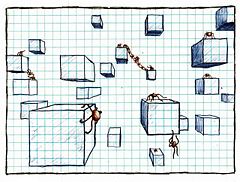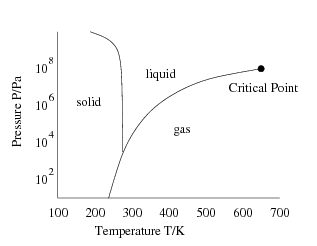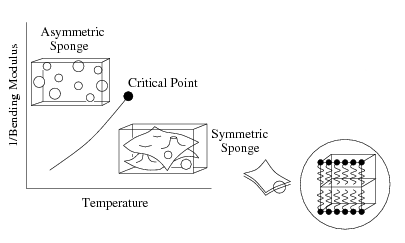Collective phenomena in economy and society
“ We have technology, finally, that for the first time in human history allows people to really maintain rich connections with much larger numbers of people. ~Pierre Omidyar ”
| ||||||||||||||
Also known as mass action, collective behavior, and artificial chemistry, collective phenomena is the tendency for a lot of small individuals (like atoms or molecules) to suddenly and dramatically change their behavior by imitating their neighbors.
Strong interactions (e.g. macroscopic systems) create lots of transitions that lead to new equilibrium phases of matter. These phases exhibit their own characteristic fluctuations, elementary excitations known as collective modes. Although a description of these phenomena at the microscopic level can be quite complicated, the longtime macroscopic behavior in the grand scheme of things is often quite simple to describe. It's comparable to the collective phenomena that happens among people in the economy and society.
- Collective Phenomena (sociology): a term for situations in which a large number of people behave simultaneously in similar ways individually without coordination
- Collective Phenomena (statistical physics): the proposition that a large number of small units acting randomly may compose a larger pattern
Physics
Phenomenal approaches based on this concept have led to certain quantum as well as classical field theories that over recent years have played a major role in shaping our understanding of condensed matter and high energy physics.
Phase Transitions
This is a classical theory
- condensation of vapor into liquid droplets
Critical Phenomena
- CTemperature
- 1st Order Phase Transition
- 2nd Order Phase Transition
Universality
Mean field Theory
Ising Model
Solitons
Perturbation theory in quantum mechanics
Quantization of magnetic flux in a superconductor
collective phenomena associated with thermodynamically large numbers of particles.
Quantum Hall effect
collective phenomena associated with thermodynamically large numbers of particles.
Economy
{{#ev:youtube|ImAD8BOBOhw}}
Technology
Collective intelligence (CI) can also be defined as a form of networking enabled by the rise of communications technology, namely the Internet. Web 2.0 has enabled interactivity and thus, users are able to generate their own content. Collective Intelligence draws on this to enhance the social pool of existing knowledge. Henry Jenkins, a key theorist of new media and media convergence draws on the theory that collective intelligence can be attributed to media convergence and participatory culture.[1] Collective intelligence is not merely a quantitative contribution of information from all cultures, it is also qualitative.
One CI pioneer, George Pór, defined the collective intelligence phenomenon as "the capacity of human communities to evolve towards higher order complexity and harmony, through such innovation mechanisms as differentiation and integration, competition and collaboration."[2] Tom Atlee and George Pór state that "collective intelligence also involves achieving a single focus of attention and standard of metrics which provide an appropriate threshold of action". Their approach is rooted in Scientific Community Metaphor.
Levy and de Kerckhove consider CI from a mass communications perspective, focusing on the ability of networked ICT’s to enhance the community knowledge pool. They suggest that these communications tools enable humans to interact and to share and collaborate with both ease and speed (Flew 2008). With the development of the Internet and its widespread use, the opportunity to contribute to community-based knowledge forums, such as Wikipedia, is greater than ever before. These computer networks give participating users the opportunity to store and to retrieve knowledge through the collective access to these databases and allow them to “harness the hive” (Raymond 1998; Herz 2005 in Flew 2008).
Researchers[3] at the MIT Center for Collective Intelligence research and explore collective intelligence of groups of people and computers.
Civilization
The Formation of Nations: 8000 years ago, the ancestors of humanity--whether they lived in sedentary villages or mobile bands, whether they collected wild foods or herded flocks or cultivated gardens--lived in a world of kin and ritual in which the exploitation of many by a few was held in check. In a millennium or less, first in Mesopotamia, then in Egypt, then in India, China, Peru, Mexico, and elsewhere, villagers were incorporated into larger polities focused on sprawling urban centers and ruled by emergent elites. Did people willingly give up their independence to join such new polities or were they coerced by despots? The Dynamics of Civilizations Group at SFI, led by SFI External Professors Henry Wright and Doug White , and Science Board Member Bob Adams , aims to explain this fundamental transformation in the human career accelerated during the 20th century.
Languages
As time passes, languages change. Vocabulary items (and grammatical features) are passed along from care-givers to children, often with alterations of meaning and/or pronunciation. This process of vertical transmission may be contrasted with the horizontal process of borrowing features from neighboring languages. A language evolves into “daughter” languages descended by vertical transmission from a common “proto-language,” with sound changes tending to follow definite rules. Meanwhile, borrowing occurs as well, which complicates the picture.
Religions
The term "religion" a cultural or behavioural aspect of ritual, liturgy and organized worship, often involving a priesthood, and societal norms of morality (ethos) and virtue (arete)
Society
Society shows sometimes abrupt changes - revolutions - which are related to phase transitions: both are sudden and dramatic changes of behavior.
Social systems are prominent examples of complex systems. Concepts, tools and models aiming at identifying generic mechanisms underlying collective phenomena in these systems are developed with the use of
Game Theory
Game theory attempts to mathematically capture behavior in strategic situations, in which an individual's success in making choices depends on the choices of others.
Gene-Culture Co-evolutionary Models
Also known as Dual Inheritance Theory(DIT), it is how human behavior is a product of two different and interacting evolutionary processes: genetic evolution and cultural evolution. DIT is a "middle-ground" between much of social science, which views culture as the primary cause of human behavioral variation, and human sociobiology and evolutionary psychology which view culture as an insignificant by-product of genetic selection.
Behavioral Experiments
War Time Sexual Violence
Sexual violence varies in extent and form among civil wars as well as inter‑state wars, among ethnic wars as well as non‑ethnic, and among secessionist conflicts. Despite the challenges to gathering data on this sensitive topic, the variation does not appear to be a product of inadequately reported violence: there are well-documented cases at the low end of the spectrum of sexual violence as well as the high end. Through multi-sited field research and new analysis of existing data, research on sexual violence at SFI, led by SFI Professor Libby Wood seeks to explain the variation in sexual violence during war. Goals include (a) documenting variation in wartime sexual violence, with particular attention to cases with little sexual violence; (b) exploring in greater depth cases where the pattern of sexual violence appears to be of particular interest in accounting for that variation; (c) developing candidate explanations for the observed variation; and (d) to the extent feasible, assessing their empirical plausibility. This project analyzes the puzzle of variation of sexual violence in the context not just of war but also in light of the cultural norms and practices of particular societies, bearing in mind that war can radically change norms and practices and that small group dynamics can profoundly undermine both individual norms and armed group policy.
Statistical Physics
Partition Function Given a thermodynamically large system that is in constant thermal contact with the environment, where both the volume and the number of constituent particles are fixed. ( = 1, 2, 3, ...) are the exact states (microstates) that the system can occupy, generally, these can be regarded as discrete quantum states of the system.
Therefore, the canonical partition function is defined as:
where
- = statistical function of Temperature
- = base of the natural logarithm
- = the inverse temperature where is the Boltzmann const
- = total energy of the system
- = the number of particles.
Agent Based Models
Agent-based modeling offers a useful theoretical portal from which to explore complex adaptive systems. This type of bottom-up modeling begins by capturing, in the form of simple algorithms, the essential behavior of the key agents in the system under investigation. These computations are then allowed to interact with one another, resulting in a new model system that can be explored. Agent-based models are well suited for the analysis of dynamical systems of heterogeneous, adaptive agents. These types of systems are often difficult to capture using more traditional modeling tools like axiomatic mathematics. Over the last two decades agent-based models have become an important tool in a variety of fields, and have been used to explore problems ranging from urban segregation to the flocking of birds to trading in markets. SFI External Professors George Gumerman and Tim Kohler and others are simulating ancient societies of the southwest, SFI Professor Steve Lansing is modeling the relation between rule based marriage and genetic relatedness in Bali, and SFI External Professors John Miller and Scott Page are modeling complex adaptive social systems using thoughtful agents.
Complex Networks Theory
In the context of network theory, a complex network is a network (graph) with non-trivial topological features—features that do not occur in simple networks such as lattices or random graphs. The study of complex networks is a young and active area of scientific research inspired largely by the empirical study of real-world networks such as computer networks and social networks.
Cooperation
Revolution
cultural conflicts and problems of social consensus are examples of phenomena being addressed.
Other Examples
Animal Magnetism, like Herding
References
- http://www.santafe.edu/research/topics-dynamics-human-behavior-institutions.php
- Soft Condensed Matter, by Richard A. L. Jones (Oxford University Press, 2007).
- Solid State Physics, by J. R. Hook and H. E. Hall (Wiley, 2007).
- http://www.tcm.phy.cam.ac.uk/~bds10/phase.html
- ↑ Flew, T. (2008). New Media: an introduction. Melbourne: Oxford University Press
- ↑ George Pór, Blog of Collective Intelligence
- ↑ http://cci.mit.edu/people/index.html













